
At the end of July, the Government of Dominica presented the budget for the 2025/26 financial year. Almost 58% of revenues come from the Citizenship by Investment (CBI) Programme. The country is showing a systematic and responsible approach to using these funds, directing them not towards short-term consumption, but into infrastructure transformation, strengthening energy independence, ensuring food security, developing healthcare, diversifying the economy, and supporting sustainable growth.
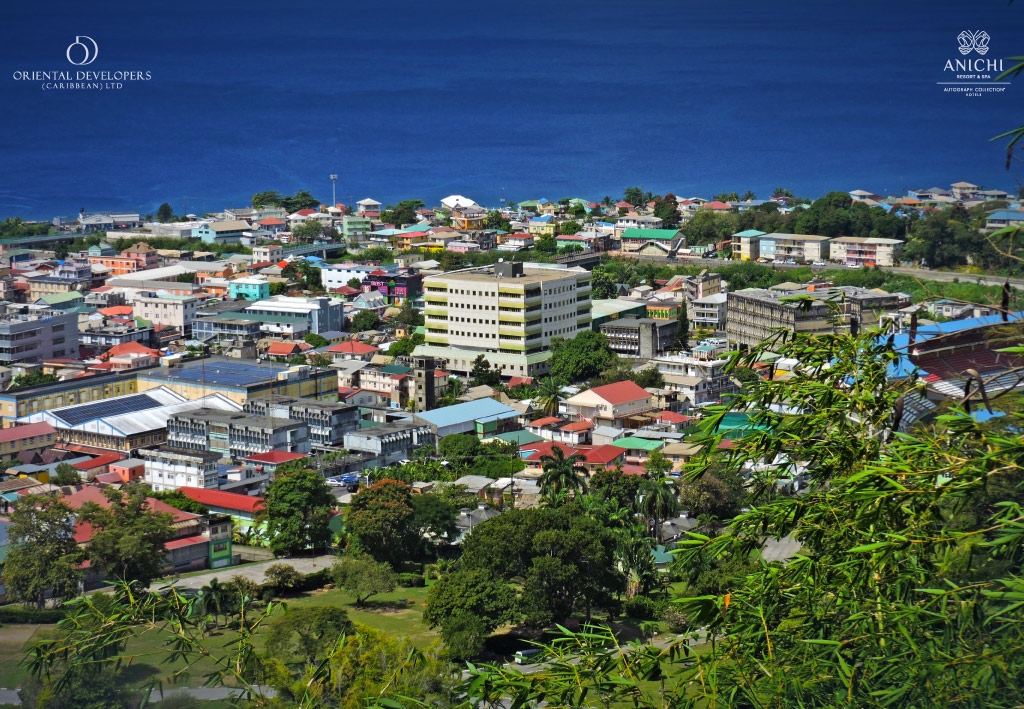
View of the capital of Dominica and the Dominica Financial Centre.
Dominica’s economic indicators continue to improve. In 2024, real GDP increased by 3.5%, and for 2025, the government forecasts an acceleration to 4.2%. Sustainable tax revenues contribute significantly to this growth: all major categories – value-added tax, income tax, and corporate tax – exceeded expectations, reflecting increased private sector activity and rising consumer demand.
Inflation, which had remained elevated in 2022–2023 under the influence of external factors, slowed to 3.1%, and in the coming years is expected to stabilise at around 2%. Price stability creates favourable conditions for attracting investment and for long-term planning.
Fiscal policy remains sustainable: the 2025/26 budget has been prepared with a primary surplus of 1% of GDP, enabling the servicing of public debt without additional pressure on current revenues. A significant share of funds obtained through the CBI Programme is allocated to financing capital investments, the total volume of which in the new budget amounts to 32% of GDP.
In parallel, measures are being implemented to create a Resilience Fund and a Debt Servicing Fund, which will help strengthen fiscal reserves, reduce macroeconomic risks, and build international investor confidence in Dominica as a jurisdiction capable of managing revenues strategically over the long term.

Luxury Private Jet Landing.
Infrastructure development remains one of the main priorities of Dominica’s public policy. The focus is on projects that not only modernise individual facilities but also create an integrated system that enhances the country’s connectivity, improves access to markets, social services, and tourism hubs.
Construction of the international airport, financed mainly through investment revenues, has reached a key stage. To date, more than 40% of works have been completed, including the critically important stage of runway levelling. Once operational, the facility is expected to radically transform the island’s transport accessibility, enabling direct air links to key destinations in North America and Europe.
Significant improvements are also taking place in the land transport network. Special priority is given to modernising eastern and southern road routes, which is particularly important for improving transport access to remote areas, reducing logistics costs for local businesses, and strengthening regional economic ties.
Simultaneously, a programme for upgrading maritime terminals is being implemented. In the port of Anse de Mai, a large-scale modernisation is under way, including the expansion of the quay line and upgrades to cargo-handling facilities. In the capital, a new ferry terminal is being built to enhance the convenience and regularity of passenger services, as well as to improve the island’s connections with neighbouring regions.
Collectively, these large-scale projects are creating not just transport infrastructure but a sustainable, interconnected territorial system able to serve current economic needs, provide a strong foundation for future growth, attract investment, and integrate the country more deeply into global production and logistics chains. This comprehensive programme turns infrastructure modernisation from a technical task into a tool for achieving genuine economic sovereignty.
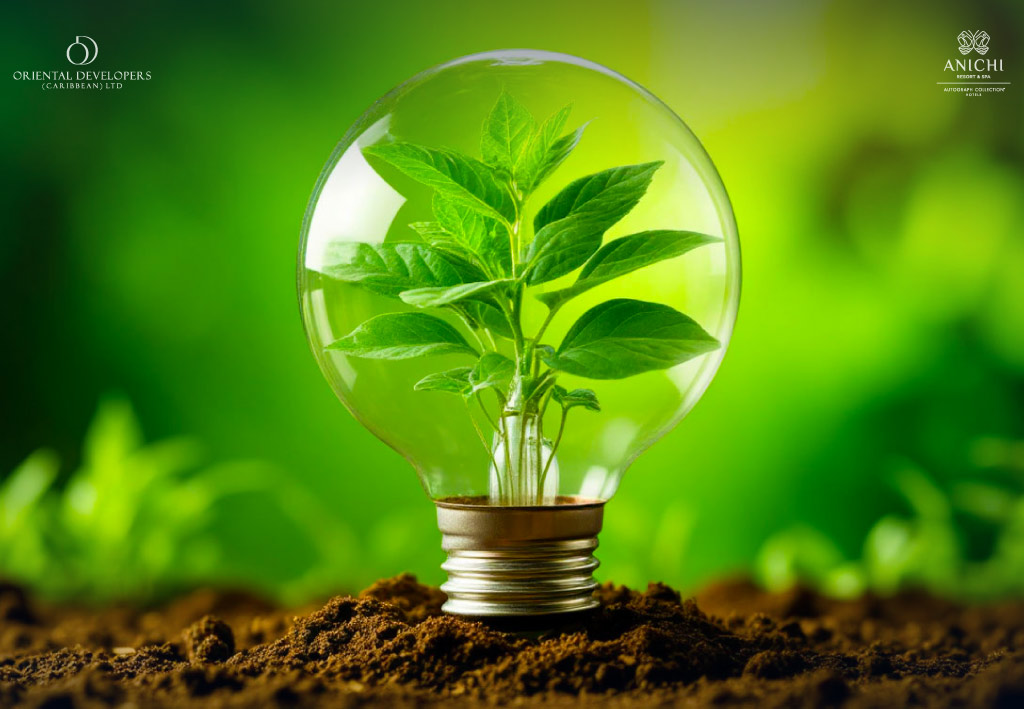
A green light towards energy sovereignty.
Dominica’s energy sector is entering a phase of deep modernisation aimed at improving reliability, reducing dependence on external supplies, and increasing resilience to climate risks. New projects in this sector not only change the structure of energy supply but also create conditions for sustainable growth in related industries.
By the end of 2025, the first geothermal power plant in the country – a project more than a decade in development – is scheduled to be launched in the Roseau Valley. The plant will provide stable power generation from a domestic resource, reduce operating costs in the energy sector, and mark an important step towards decarbonising the economy.
At the current stage of the energy upgrade, a large-scale project is being implemented to build a new electricity transmission system worth US$116.1 million. The network is designed to withstand extreme weather conditions – including Category 5 hurricanes – and will cover the country’s main regions. These investments are not just about reliability but about energy security for decades ahead.
Additional flexibility is provided by an already commissioned 5MW energy storage system, which helps balance grid load, reduce generation costs, and ensure stable power supply during peak demand periods.
The combination of geothermal generation, resilient grids, and modern storage facilities lays the foundation for the country’s future energy autonomy. Dominica is creating not just reserve capacity but a full energy architecture capable of supporting the economy, protecting infrastructure, and reducing vulnerability to external shocks.
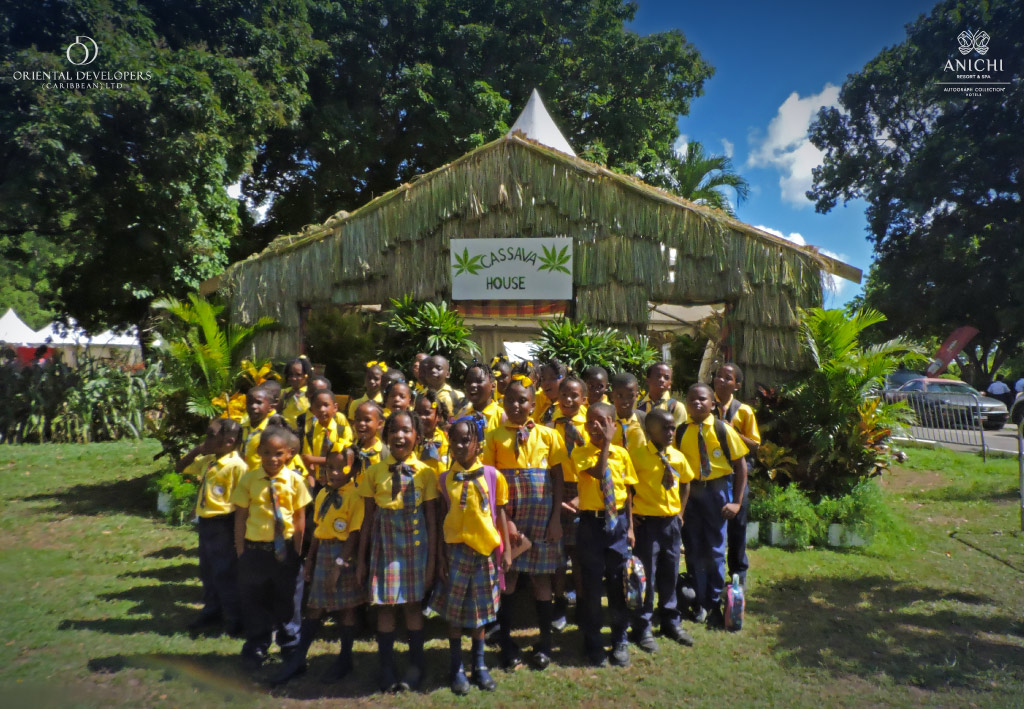
Children gather at the entrance of Ti Vilaj Kweyol’s Cassava House in 2024, where displays showcase the remarkable versatility of this traditional crop.
Dominica’s agricultural sector is gaining fresh momentum through comprehensive investment in sustainable production and food security. The focus is not only on production volumes but also on improving quality, export potential, and engaging a new generation of farmers.
The central crop production project is the construction of a modern citrus certification centre in Londonderry worth US$7.7 million. The centre will enable the production of up to 50,000 seedlings annually and the restoration of up to 1,000 acres of citrus plantations.
Additionally, with support from China, a lab for plant propagation using tissue culture has been established. Priority crops include bananas, dasheen, vanilla, and pineapple, providing farmers with high-quality planting material.
In livestock, a national abattoir project is underway in Layou Park worth US$5.1 million, with capacity for processing 1,000 poultry per hour and 50 pigs per day. Construction of 124 farming facilities is also ongoing, with completion expected by August 2025.
In 2025, US$762,000 has been allocated to improve farm logistics: upgrading the Neba Road, Captain Bruce, and Mero–Carholme routes, as well as starting work on the Buck/Bunnette Feeder Road and Mopo Road. Improved farm access will reduce logistics costs and minimise post-harvest losses.
To reduce investment barriers, a subsidy system covers:
For the first time, a government crop insurance programme – for bananas, plantains, and other vulnerable crops – has been introduced, co-financed by the state. These measures create a predictable environment for farmers and encourage a shift towards more productive and environmentally friendly practices.
The National Agricultural Education Programme (NAEP) engages young people: 20 schools participate in 4-H clubs, developing school gardens and learning hydroponic techniques.
The National Association of Youth in Agriculture (NAYA) runs a comprehensive support programme. The US$3.2 million allocated supports 138 small agribusinesses. Training placements have been completed in Antigua and Costa Rica, and under the new land policy, young farmers are being offered 300 acres of land for lease at a symbolic US$1 per year for the first five years.
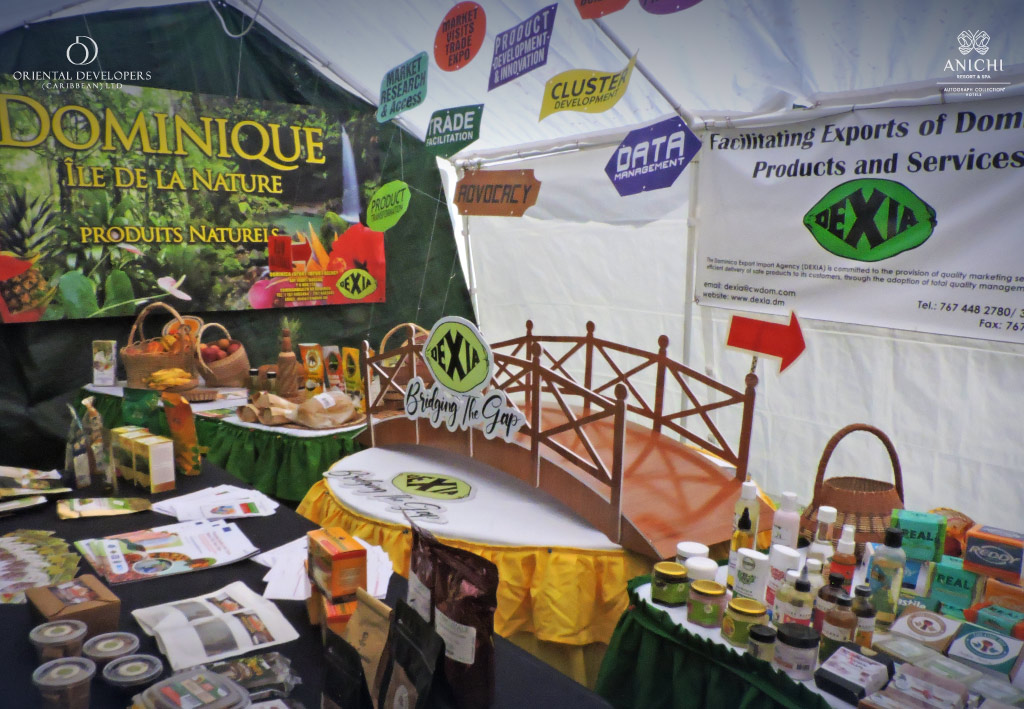
The DEXIA exhibition stand at Ti Vilaj Kweyol (2024) highlights Dominica’s rapidly expanding export sector.
Local brands with export potential are also developing – from Bee Natural cosmetics and Aqua Botanical’s sea moss products to Nelly’s Plantains Chips and Mama Cheveux’s hair care products.
Export volumes are growing rapidly. In 2024–2025, 3.8 million pounds of plantains, dasheen, and ginger were shipped abroad, including pilot shipments to Miami (61,500 pounds of plantains). The state-owned DEXIA increased purchases from 587 farmers by US$1.9 million and is preparing new shipments to the USA and the UK.
In 2025, work will start on creating a National Agro-Processing Centre and a network of regional hubs for SMEs, accelerating the shift from raw exports to value-added products.
By 2030, Dominica plans to increase agriculture’s contribution to GDP to US$700 million. At the heart of the strategy are technological modernisation, youth entrepreneurship support, and integration into global supply chains. Thus, agriculture becomes not just a guarantor of food security but also a driver of exports and sustainable economic growth.
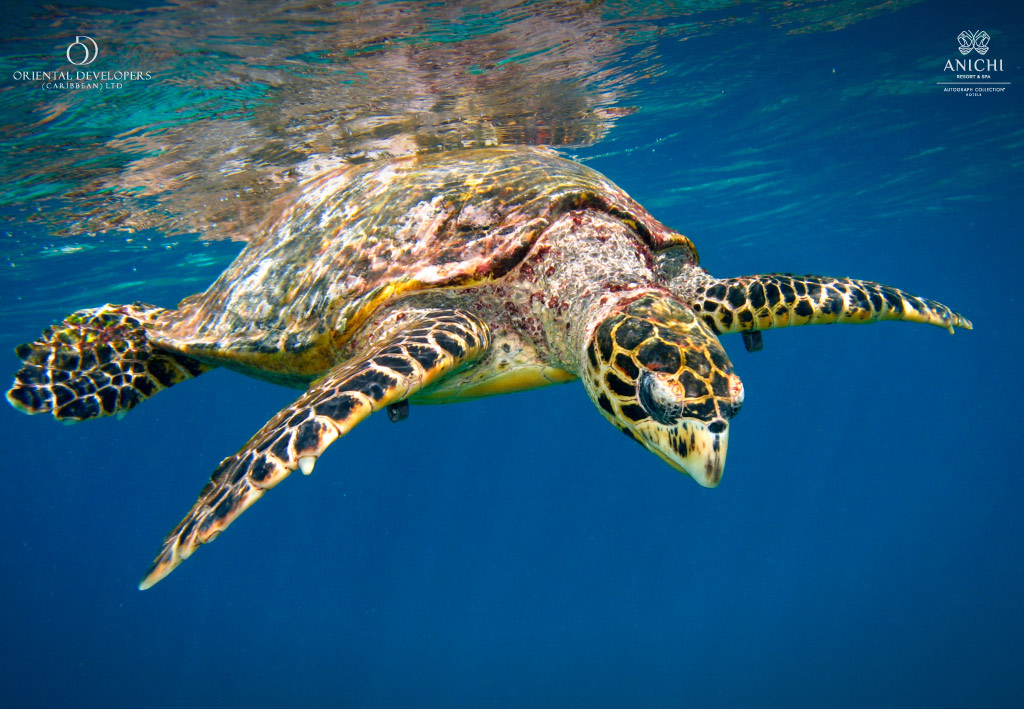
Hawksbill sea turtles, a critically endangered species, nest on Dominica’s beaches between May and October.
Dominica is strengthening its position as an environmentally focused maritime nation, combining the protection of marine ecosystems with the modernisation of the fishing sector and the development of sustainable employment in coastal communities. In the 2025/26 financial year, investments are being directed both into conservation initiatives and into infrastructure, processing, and exports.
A flagship initiative is the creation of the world’s first sperm whale reserve. The bill passed its first reading in June 2025, with final adoption expected in the autumn. The reserve will cover waters inhabited by a unique population of sperm whales, ensuring not only their long-term protection but also the development of scientific tourism, educational programmes, and partnerships with international environmental foundations.
To support traditional fishing and sustainable income growth in coastal areas, EC$5.2 million is allocated in 2025/26. Funds are being used to build and hand over to fishermen 53 modern vessels, 20 of which are already in operation.
Reconstruction of fishing jetties in Bioche and Dublanc has been completed, while works continue in Mahaut, and will commence at Newtown, Fond Cole, Stowe, Scotts Head, and San Sauveur in August. Improved shore infrastructure increases access to marine resources, enhances fishing safety, and encourages young people to enter the sector.
Management of the central fish market in Roseau has been transferred to the state corporation DEXIA, enabling the introduction of product quality control and the start of certification processes for EU and US exports of Dominican seafood.
As part of the new export drive, systematic efforts have begun to expand supplies to CARICOM markets, as well as to the USA and the UK. Raising processing, storage, and packaging standards will help increase export potential and the value added in the sector.
Fishing sector modernisation goes hand in hand with the development of marine ecotourism: training courses for guides and instructors are being introduced, and new jobs are being created in reef protection and coastal zone monitoring. This comprehensive approach has a dual effect: boosting local incomes while cultivating a new generation of specialists working at the intersection of ecology and entrepreneurship.
Dominica’s blue economy is becoming a key element of the national development strategy – as a tool for diversification, employment, and international positioning. Combining conservation measures, fishing sector modernisation, and sustainable tourism support enables a development model where economic growth does not contradict ecosystem protection but directly depends on it.
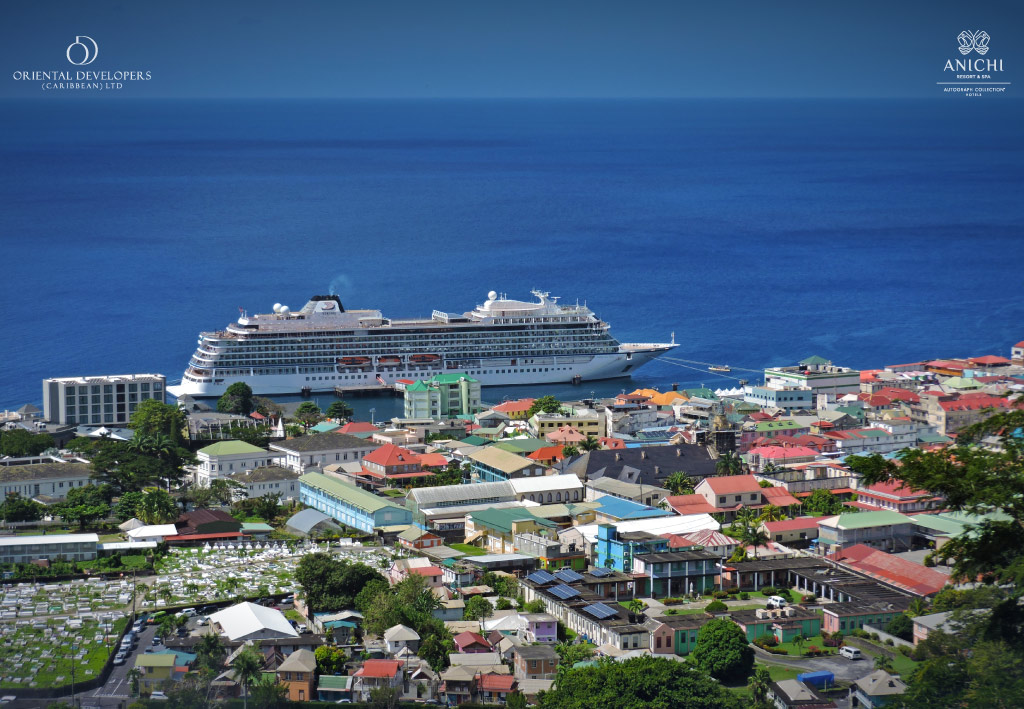
A cruise ship docked in Roseau, the vibrant capital of Dominica.
Dominica’s tourism industry is showing steady growth, reflecting both the global tourism recovery and the effectiveness of domestic policy. In the 2024/25 financial year, cruise passenger arrivals rose by 83% compared to the previous period, and hotel occupancy exceeded pre-pandemic levels by 35.1%. The 2024 Creole Music Festival attracted 9% more visitors, while the 2025 Mas Dominique Carnival increased tourist numbers by 35%.
Hotel infrastructure development is accompanied by a new state ‘Village Stays’ policy to support small hotels and guesthouses in rural and coastal areas. In 2025/26, pilot projects will be launched in three to five villages. The programme stimulates local entrepreneurship, engages residents in developing the hospitality industry, and ensures a more even distribution of tourism revenues between regions.
Improving transport connectivity remains a key condition for sustainable tourism growth. Alongside the construction of the international airport, from August 2025 Caribbean Airlines will launch a San Juan–Dominica route. Negotiations are underway to expand the network with British Airways, Virgin Atlantic, and Condor, as well as exploring routes to Toronto, Atlanta, and St Thomas. Expanding the route map will improve the island’s international accessibility and lay the foundation for further growth in 2026.
Ecotourism is receiving institutional backing: from 2026, a mandatory environmental levy of US$30 will be charged to foreign tourists, with funds directed to marketing and maintenance of natural sites. Revenues from visits to natural attractions in the 2024/25 financial year totalled EC$1.44 million. From October 2025, paid access will be introduced at new locations – Titou Gorge and Cold Soufrière – expanding the country’s tourist map and creating additional revenue sources.
To develop human capital, training for tour guides continues, including for Waitukubuli National Trail routes, as well as grants for converting private homes along tourist routes into guesthouses.
If current growth rates are maintained and the announced initiatives are successfully implemented, the tourism sector has the potential to take a significantly larger share of GDP by 2026, consolidating its position as one of the key drivers of sustainable economic development and territorial integration.
Taken together, the measures being implemented are creating a diversified tourism ecosystem that combines premium hotel projects, rural tourism initiatives, environmental sustainability, and expanded international accessibility. Dominica is pursuing a strategy in which tourism becomes not only a source of income but also a tool for community integration, cultural exchange, and promoting the national image globally.

The future in motion – where tech meets transformation.
Developing digital infrastructure is becoming an important element of Dominica’s government strategy, helping to increase administrative efficiency, engage young people, and modernise key industries technologically. The priority is not only creating electronic services but also building a digital skills ecosystem.
The central element of digital policy remains the national eServices portal, which handled over 13,000 transactions in the 2024/25 financial year. Expanding the range of available services – from business registration to administrative certificates – improves transparency, reduces bureaucratic barriers, and simplifies citizens’ access to government functions.
Significant reforms are also taking place in the fiscal sphere, with the introduction of a new tax system on the agenda. The reform aims to improve the efficiency of administration and simplify calculations for businesses.
In the tourism sector, digital solutions are emerging for payment and accounting of visits to natural sites, including mobile POS terminals for taxi drivers and guides.
In healthcare, a US$15.5 million Health Management and Information System (HMIS) is being implemented, integrating electronic medical records, diagnostics, and treatment histories across all medical institutions. The first module will be launched by 31 December 2025. A total of 49 modules are planned, covering diagnostics, treatment, and finance.
Special attention is paid to digital education and innovation. In 2025/26, a Fab Lab digital prototyping laboratory will open at Dominica State College, where young people can learn 3D printing, microcontroller programming (Arduino), and basic electronics.
This initiative aims to develop entrepreneurial potential and train specialists for high-tech sectors such as renewable energy and engineering.
Already in 2024/25, 79 small enterprises received grants for business process digitalisation, confirming support for digital transformation in the private sector.
Thus, Dominica’s digital transformation is moving from a supporting role to becoming a full-fledged tool of sustainable development – able to improve public services, accelerate economic modernisation, and ensure technological independence. In the long term, digital sovereignty will be as significant as physical infrastructure, moving Dominica towards being an adaptive, innovative, and competitive economy of the future.

A focused woman performs a muscle-stretching exercise on a yoga mat in a modern gym.
One of the key priorities of Dominica’s 2025/26 budget remains healthcare. The sector received the second largest allocation among all ministries, amounting to 10.7% of total current expenditure. This significant commitment underscores the strategic importance of national health as the foundation of sustainable development.
The government is increasing its emphasis on preventive healthcare, particularly in tackling non-communicable diseases (NCDs), which account for three out of four deaths in the country. The dedicated NCD unit is expanding its programme portfolio – in 2025/26, two major public information campaigns will be launched, focusing on healthy lifestyles, balanced nutrition, and early detection of risk factors. Prevention is becoming not only a medical task but also an important component of economic resilience.
Alongside upgrading facilities and equipment, the government is strengthening the healthcare workforce. From 1 August 2025, 11 new positions for medical specialists will be created. Doctors’ pay conditions have been reviewed, with a system of both non-monetary and monetary incentives introduced: ten quarterly awards will be granted for outstanding service, based on patient feedback.
The range of medical services has been significantly expanded. Public facilities now offer contrast-enhanced magnetic resonance imaging, vascular surgery, and a dedicated ophthalmology centre.
Infrastructure modernisation is continuing in parallel: construction and refurbishment of hospitals and clinics across the country are being financed, ensuring equitable access to quality care, reducing pressure on central facilities, and increasing public confidence.
For the first time in recent years, a systemic approach to mental health is being prioritised. Since June 2025, with support from the Pan American Health Organisation (PAHO), mental health legislation has been under review. Plans include expanding counselling and psychosocial services in schools, police stations, and public institutions.
Beyond medical care, the budget maintains its focus on vulnerable groups. Public programmes support the elderly, people with chronic illnesses, and low-income families – including through transfers for medical service costs, provision of medicines, and subsidised hospital meals.
Together, these measures are creating a holistic, sustainable healthcare model – preventive in focus, enhanced by digital tools, and evenly accessible nationwide. Dominica is building a system capable of responding effectively not only to current challenges such as rising chronic disease rates and workforce shortages, but also to long-term threats – from population ageing to new global epidemics – while maintaining a quality of life befitting one of the healthiest nations in the region.
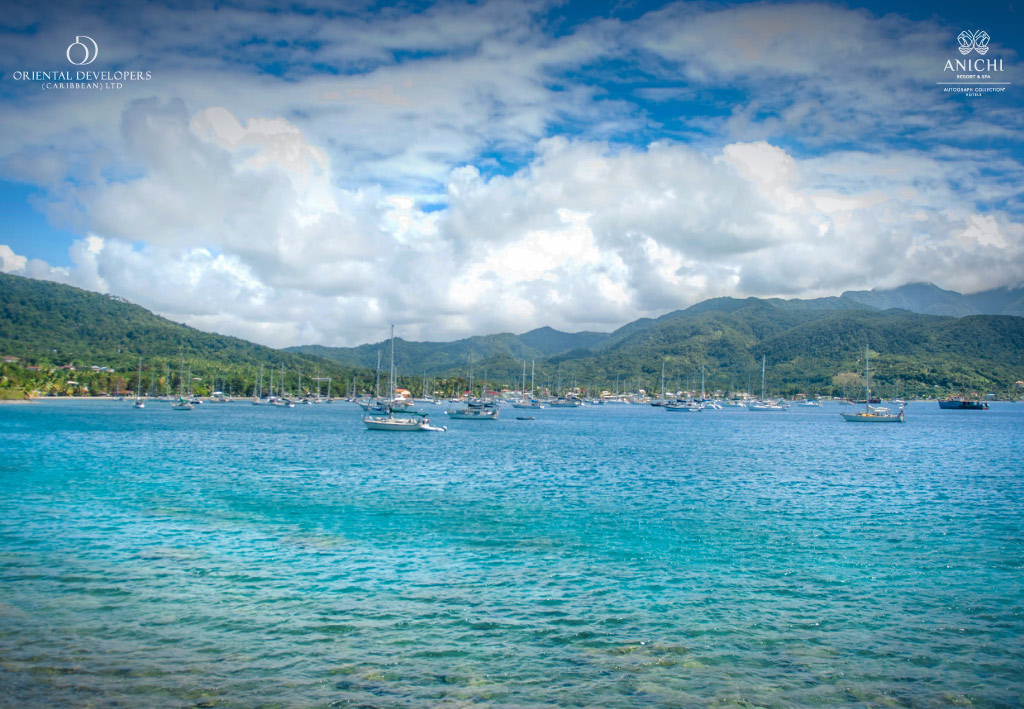
A scenic view of Prince Rupert Bay in Dominica, with several yachts anchored in the calm turquoise waters.
Dominica is reinforcing its status as one of the global leaders in climate resilience. In 2025, the country received official recognition as the first small island state to achieve carbon-neutral status under the REDD+ mechanism (Reducing Emissions from Deforestation and Forest Degradation), implemented under the auspices of the United Nations. This placed Dominica among only eight countries worldwide — and the only small island developing state — alongside larger “rainforest” nations such as Guyana and Suriname. The achievement was the result of years of work to preserve tropical forests, which cover more than 60% of the country’s territory, and the transition to a low-carbon growth model.
At the heart of the climate agenda remain projects supported by the Green Climate Fund (GCF). In 2025/26, Dominica will continue implementing infrastructure initiatives to strengthen coastal zone adaptation to climate change, protect biodiversity, and promote sustainable resource management. One key task is reducing dependence on diesel generation in the maritime sector: work has begun on creating a shore power system allowing cruise and cargo ships to switch off their engines while docked, cutting air pollution and greenhouse gas emissions.
Another step towards an environmentally focused economy will be the creation of the country’s first eco-industrial park. The concept envisages housing enterprises that use renewable energy, apply circular economy principles, and minimise waste. Support for this direction is already built into the budget through allocations for green technology development and waste management infrastructure: a comprehensive management plan is being prepared, including sorting, recycling, and sustainable disposal.
Financial sustainability of conservation efforts is ensured by a systematic approach to ecotourism management. New access fee mechanisms, partnerships with the private sector, and environmental levies are creating a stable funding base for maintaining national parks, trails, and unique natural sites. Tourism is thus becoming not only a source of revenue but also a tool of long-term environmental policy.
Dominica’s strategy clearly articulates a shift from reactive nature protection to active management of natural capital. A key element is turning ecology into a full-fledged economic asset – both by accessing international climate funds and by creating sustainable forms of employment and income. In the face of increasing climate instability, Dominica is showing how a small nation can use natural resources not as a given, but as the foundation for sovereign development.
Dominica’s 2025/26 budget demonstrates how revenues from the Citizenship by Investment Programme are becoming the basis for systemic transformation – from geothermal energy to marine reserves, from digitalisation to agricultural exports. Unlike approaches focused on short-term gain, Dominica is building a model in which every dollar earned through the programme works towards long-term goals – resilience, integration, and economic sovereignty.
For investors, this means not just purchasing property, but participating in a strategy recognised by international organisations and aligned with the principles of responsible development. An investment in a government-approved hotel project is a contribution to tourism, job creation, improved accessibility, and the country’s reputation as a stable and reliable jurisdiction.
Dominica is transforming its Citizenship by Investment Programme into an effective mechanism for national modernisation – and offers the opportunity to become a partner in implementing this long-term strategy.